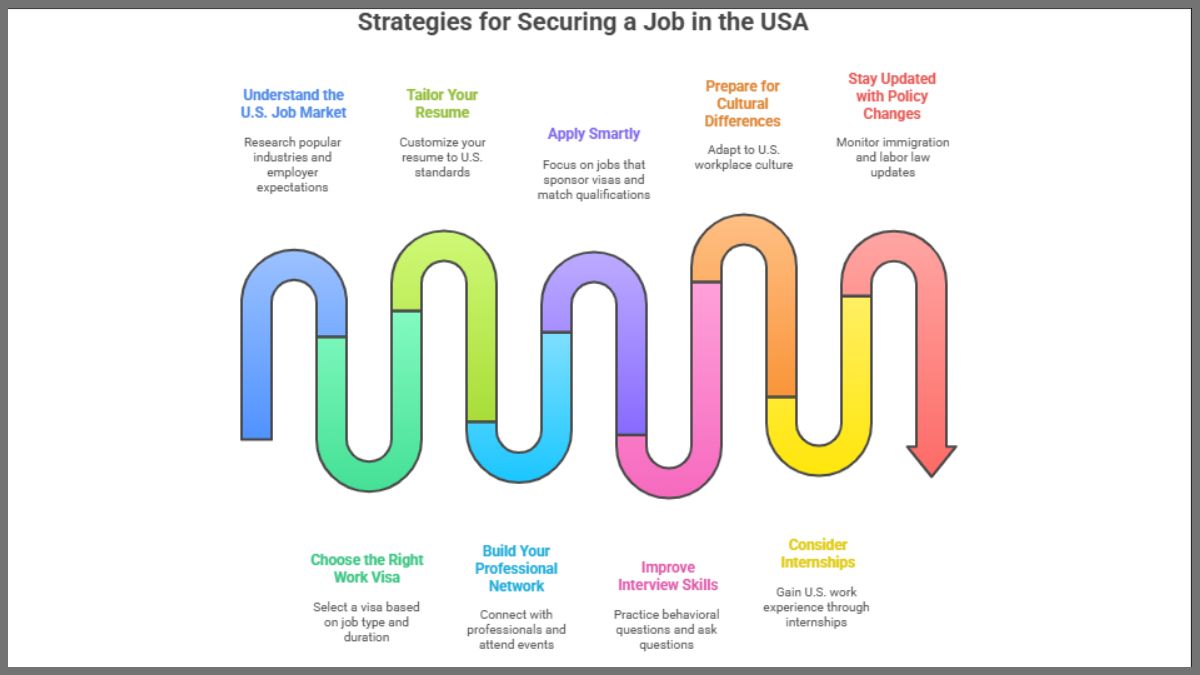Looking to start a career in the United States? You’re not alone. Every year, thousands of professionals from around the world dream of working in the U.S. But with a competitive job market and immigration rules to navigate, the process can feel overwhelming. The good news? It’s totally doable—with the right approach.
In this blog post, we’ll break down how to get a job in the USA using simple, practical steps that have helped many job seekers succeed. Whether you’re an international student, an experienced professional, or someone exploring global opportunities, these strategies will give you a roadmap to follow.
Strategies to Successfully Get a Job in USA
1. Understand the U.S. Job Market
Before sending out applications, it’s crucial to understand how hiring works in the U.S. Most American employers look for more than just qualifications—they want cultural fit, soft skills, and steady work history.
Popular Industries for Foreign Workers
- Technology (especially Software Engineering, Data Science, and Cybersecurity)
- Healthcare (including Nursing, Physical Therapy, and Medical Research)
- Engineering (Civil, Mechanical, and Electrical)
- Finance and Accounting
- Education and Research
According to the U.S. Bureau of Labor Statistics, the tech industry alone is expected to grow by 15% from 2021 to 2031, adding nearly 682,800 new jobs. That’s a huge opportunity!
2. Choose the Right Work Visa
If you’re not a U.S. citizen or Green Card holder, you’ll need a valid work visa. The U.S. offers several visa types for foreign professionals. Choosing the right one depends on your job type and duration of stay.
Common U.S. Work Visas
- H-1B Visa: For specialty occupations with a bachelor’s degree or equivalent.
- L-1 Visa: For internal transfers within international companies.
- O-1 Visa: For individuals with extraordinary ability in arts, sciences, or business.
- J-1 Visa: For internships, fellowships, and academic training.
Note: The H-1B visa is the most popular but has an annual cap, so timing your application is critical. In 2023, the U.S. Citizenship and Immigration Services (USCIS) received over 780,000 H-1B registrations during the application window—a nearly 60% jump from the previous year.
3. Tailor Your Resume to U.S. Standards
One of the fastest ways to get noticed is by presenting a strong, U.S.-style resume. Unlike CVs in some countries, a resume in the U.S. is typically one page (two at most) and focused on results.
Resume Tips for Success
- Start with a brief summary at the top highlighting your strengths.
- Use bullet points with action verbs (e.g., Increased sales by 20%, Managed a team of 10).
- List work experience in reverse chronological order.
- Don’t include personal details like age, marital status, or photo.
- Customize your resume for each job application using keywords from the job description.
Pro tip: Use tools like Jobscan or Resume Worded to compare your resume against job postings and improve your chances of getting past Applicant Tracking Systems (ATS).
4. Build Your Professional Network
In the U.S., who you know can be just as important as what you know. Many jobs are filled through referrals before ever being posted.
Ways to Network Effectively
- Use LinkedIn to connect with professionals in your field.
- Attend industry-specific webinars, virtual meetups, and career fairs.
- Reach out to alumni from your school who now work in the U.S.
- Join professional organizations related to your field (like IEEE, AMA, etc.).
Don’t be shy—send a message asking for advice, not a job. People are often willing to help if you’re respectful and genuine.
5. Apply Smartly, Not Randomly
It’s tempting to blast your resume to hundreds of companies. But that approach rarely works. Focus on jobs that sponsor work visas and match your qualifications.
Top U.S. Job Boards for International Applicants
- Indeed
- H1BData.info – Lists U.S. companies with a history of sponsoring H-1B visas
- MyVisaJobs
- Google Jobs
Make a shortlist of 10–15 companies and tailor your applications to them. This focused effort can yield better results than mass applications.
6. Improve Your Interview Skills
U.S. job interviews often include behavioral questions like:
- “Tell me about a time you faced a challenge and how you handled it.”
- “Describe a successful project you led.”
Use the STAR method (Situation, Task, Action, Result) to answer clearly. Practice with a friend or record yourself to refine your delivery.
Also, remember to ask questions! Employers value curious candidates who want to know more about the company and role.
7. Prepare for Cultural Differences
Workplace culture in the U.S. might be different from what you’re used to. Punctuality, direct communication, and teamwork are often highly valued.
Here are a few cultural tips to remember:
- Be punctual: Always be on time for meetings and deadlines.
- Be concise: Keep emails short and to the point.
- Speak up: Don’t hesitate to share ideas in meetings—it shows initiative.
Adjusting may take time, but adaptability is key to long-term success in any job market.
8. Consider Internships or Volunteering
If you’re having trouble landing your first job, consider getting your foot in the door through an internship, OPT (Optional Practical Training), or volunteering. These roles may not pay much (or at all), but they give you U.S. work experience, which is a big bonus on your resume.
For international students graduating from U.S. universities, OPT is an excellent way to gain 12–36 months of work experience, depending on your field of study.
9. Stay Updated with Policy Changes
U.S. immigration and labor laws can change, especially with each new administration. Keep an eye on updates from official channels like:
- USCIS.gov (U.S. Citizenship and Immigration Services)
- U.S. Department of State
For example, recent updates proposed by the Biden administration aim to streamline the H-1B process and make it more merit-based. Tools like Boundless Immigration and Legalpad.io offer easy-to-understand updates and support for visa applicants.
Final Thoughts
Getting a job in the U.S. might seem like a big challenge—but with planning, persistence, and a little flexibility, it’s within reach. Focus on building skills, networking smartly, and targeting companies that value international talent. There’s no one-size-fits-all path, but if others have done it, so can you.
So, what’s your next step? Maybe it’s rewriting your resume, signing up for a virtual job fair, or simply reaching out to a connection on LinkedIn. Every small step matters on your journey to a career in the USA.
If you have questions or want to share your own job search experience, feel free to drop a comment below. We’d love to hear your story!





